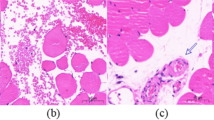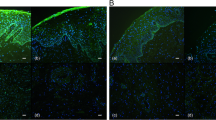Abstract
Pelvic floor connective tissue degeneration is closely associated with retrogradation of its dominating nerve fibers. We hypothesized that some neuropeptides from pelvic floor tissue might be involved in the pathological progress of stress urinary incontinence (SUI) and pelvic organ prolapse (POP) in women. Thirty premenopausal and 31 postmenopausal patients participated in the study. The morphological appearance in the vaginal tissue was examined. The vasoactive intestinal peptide (VIP) and pituitary adenylate cyclase activating polypeptide-38 (PACAP) immunoreactivities (ir-VIP, ir-PACAP) were tested by immunohistochemistry and radioimmunoassay. We found that the VIP and PACAP immunostainings were weaker and sparser, and ir-VIP and ir-PACAP levels were significantly decreased in the anterior vaginal wall in the premenopausal and postmenopausal SUI or POP patients. Ir-VIP and ir-PACAP levels were reversely correlated with the age and menopausal status in the SUI or POP patients. Our data suggest that VIP and PACAP may participate in the pathophysiological process of SUI and POP.


Similar content being viewed by others
References
Weidner AC, Barber MD, Visco AG, Bump RC, Sanders DB (2000) Pelvic muscle electromyography of levator ani and external anal sphincter in nulliparous women and women with pelvic floor dysfunction. Am J Obstet Gynecol 183:1390–1401
DeLancey JOL (1993) Anatomy and biomechanics of genital prolapse. Clin Obstet Gynecol 36:897–909
Busacchi P, De Giorgio R, Santini D, Bellavia E, Perri T, Oliverio C, Paradisi R, Corinaldesi R, Flamigni C (1999) A histological and immuno-histochemical study of neuropeptide containing somatic nerves in the levator ani muscle of women with genitourinary prolapse. Acta Obstet Gynecol Scand 78:2–5
Busacchi P, Perri T, Paradisi R, Oliverio C, Santini D, Guerrini S, Barbara G, Stanghellini V, Corinaldesi R, De Giorgio R (2004) Abnormalities of somatic peptide-containing nerves supplying the pelvic floor of women with genitourinary prolapse and stress urinary incontinence. Urology 63:591–595
Abrams P, Blaivas JG, Stanton S, Andersen JT (1988) ICS standardization of terminology of lower urinary tract function. Neurourol Urodyn 7:403–426
Song Y, Hong X, Yu Y, Lin Y (2007) Changes of collagen type III and decorin in paraurethral connective tissue from women with stress urinary incontinence and prolapse. Int Urogynecol J 18:1459–1463
Sievert KD, Bakircioglu ME, Tsai T (2004) The effect of labor and/or ovariectomy on rodent continence mechanism. Part II: the neuronal changes. World J Urol 22:244–250
Oh SJ, Hong SK, Kim SW, Paick JS (2003) Histological and functional aspects of different regions of the rabbit vagina. Int J Impot Res 15:142–150
Giraldi A, Alm P, Werkstrom V, Myllymaki L, Wagner G, Andersson KE (2002) Morphological and functional characterization of a rat vaginal smooth muscle sphincter. Int J Impot Res 14:271–282
Ziessen T, Moncada S, Cellek S (2002) Characterization of the non-nitrergic NANC relaxation responses in the rabbit vaginal wall. Br J Pharmacol 135:546–554
Vaudry D, Gonzalez BJ, Basille M, Yon L, Fournier A, Vaudry H (2000) Pituitary adenylate cyclase-activating polypeptide and its receptors: from structure to function. Pharmacol Rev 52:269–324
Costagliola A, De Man JG, Majewski M, Lakomy M, Cecio A, Robberecht P, Pelckmans PA, Adriaensen D, Timmermans JP (2004) Coexistence of non-adrenergic non-cholinergic inhibitory and excitatory neurotransmitters in a large neuronal subpopulation in the vaginal segment of the chicken oviduct. Auton Neurosci Basic Clin 112:37–48
Graf AH, Schiechl A, Hacker GW, Hauser KC, Steiner H, Arimura A, Sundler F, Staudach A, Dietze O (1995) Helospectin and pituitary adenylate cyclase activating polypeptide in the human vagina. Regul Pept 55:277–286
Fritel X, Fauconnier A, Levet C, Benifla JL (2004) Stress urinary incontinence 4 years after the first delivery: a retrospective cohort survey. Acta Obstet Gynecol Scand 83:941–945
Kerns JM, Damaser MS, Kane JM, Sakamoto K, Benson JT, Shott S, Brubaker L (2000) Effects of pudendal nerve injury in the female rat. Neurourol Urodyn 19:53–69
DeLancey JOL (1994) Structural support of the urethra as it relates to stress urinary incontinence: the hammock hypothesis. Am J Obstet Gynecol 170:1713–1723
Parazzini F, Colli E, Origgi G, Surace M, Bianchi M, Benzi G, Artibani W (2000) Risk factors for urinary incontinence in women. Eur Urol 37:637–643
Swift SE, Pound T, Dias JK (2001) Case-control study of etiologic factors in the development of severe pelvic organ prolapse. Int Urogynecol J Pelvic Floor Dysfunct 12:187–192
Luna MT, Hirakawa T, Nakano H (2000) Urinary incontinence in women seen in the obstetrics and gynecology clinic. Int Urogynecol J Pelvic Floor Dysfunct 11:277–281
Peyrat L, Haillot O, Bruyere F, Boutin JM, Bertrand P, Lanson Y (2002) Prevalence and risk factors of urinary incontinence in young and middle-aged women. BJU Int 89:61–66
Conflicts of interest
None.
Author information
Authors and Affiliations
Corresponding author
Additional information
This study was supported by a grant from the Fujian Science and Technology Bureau Foundation (grant no. 2000I1003).
Rights and permissions
About this article
Cite this article
Hong, X., Huang, L. & Song, Y. Role of vasoactive intestinal peptide and pituitary adenylate cyclase activating polypeptide in the vaginal wall of women with stress urinary incontinence and pelvic organ prolapse. Int Urogynecol J 19, 1151–1157 (2008). https://doi.org/10.1007/s00192-008-0585-z
Received:
Accepted:
Published:
Issue Date:
DOI: https://doi.org/10.1007/s00192-008-0585-z




